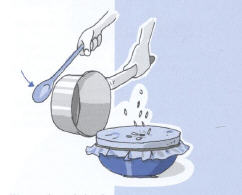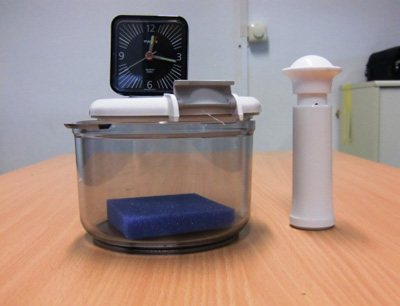Session 2: Sound propagation and transmission
Objectives: In the neighbourhood of airports sometimes the windowpane starts to clink, especially when the house has windows with single glazing. This can also observed when a helicopter passes the house. In this session the objectives are
- to understand how sound travels from one place to another
- to get to know the wavelike behaviour of sound. As in many movies shown space ships movement is attended by sound from the propulsion system. On the question if there is air in space the pupils would probably answer: no, it is a vacuum. So what happens when an alarm clock rings in a vacuum? The pupils will learn
- that the sound transmission is coupled to a medium.
Vibrations generated by a sound source cause alternating compression and rarefaction of the surrounding air molecules. These alternating compression and rarefaction propagate in form of a longitudinal wave in the air and can excite vibrations of other objects. The vibrations propagate in all directions. Sound can also travel through liquids and solids but contrary to light not through a vacuum.
Maximum duration
45min
Material
- Slinky
- Magnet role model
- Newton’s cradle
- Vacuum tank & alarm clock
- Tambourine or box spanned with a plastic foil & rice or sand grains
- Balloon
- Tin can telephone
- Spoon & cord
- Tuning fork

fig.3 Wave demonstration with a slinky

fig.4 Transportation of sound energy through air

fig 5 Vacuum tank, alarm clock and handheld pump to evacuate the tank
Introduction/Starters
Ask the students if they know, how the sound is emitted by a sound source, e.g. how the words of a speaker travels to the ear of the hearer. Ask them about the concept of a wave they have in mind (What is the sound “wave” made of?). Depending on the education level, try to introduce the difference between transversal and longitudinal waves. You can use Newton’s cradle to show the transportation of energy.
Main activities
Ask the pupils what they think what happens with the air molecules around a vibrating sound source like a tuning fork. Draw a simple sketch of a tuning fork or ruler with the surrounding air molecules to explain the alternating compression and rarefaction of the air molecules. If the pupils have already known the concept of air density and pressure one can use these experiments to make it visible:
1) Let the pupils play around with the slinky, than let two of them hold it on the ends and stretch it (fig 3). Ask them to make waves and discuss the longitudinal wave. Build a bridge to sound transport. Alternatively use the Magnet role model if available.
Explanation: A sound wave transports only sound energy and not air molecules. The molecules vibrate around their rest position like the windings of the slinky. The model to be used for sound energy transportation through air is a chain conductor made from masses and springs.
2) Show with the aid of two tambourines (or one tambourine and a cooking pot) and rice the transportation of sound energy through air. (fig. 4)
Explanation: When hitting the first tambourine the drumhead starts to vibrate and with it the surrounding air. The radiated energy from the tambourine is transmitted through air in the form of a wave. This wave causes a back and forth movement of the drumhead of the second tambourine. This drumhead vibration is the reason why the rice is jumping.
3) Connect the cord to the spoon and let a pupil hold the free end of the cord to one ear. Press it with a finger to the ear and let the other end with the spoon hang free. Hit the spoon with something solid (e.g. another spoon). It sounds like the chime of a huge bell. You can use the tin can telephone to demonstrate this effect, too.
Explanation: Explain, that sound is not only transported in air, but also in solid materials like the cord or even a table. But in solid materials the speed of sound differs from that in air. This is the reason why the spoon sounds like the chime of a huge bell.
4) What happens in vacuum? Start the alarm clock and put it into the plastic box. Close the box and ask a pupil to evacuate it with the air pump (fig. 5). Observe how the alarm gets quiet and Ioud again if opened.
Hint
To evacuate the plastic box with the hand pump is very time consuming. You need to pump for two minutes or even longer. The effect is hearable when you open the box again but not during the process of evacuation. It is better to use a vacuum bell jar with an electric pump for physical experiments which can be found in many schools.
Explanation
Here we have two effects: First when closing the plastic box the ringing of the alarm clock softens due to the insulation of the box. Second when evacuating the box the number of air molecules decreases. As a sound wave needs a transport medium the sound dies away in the vacuum. When opening the box again, the air pours into it and a sound wave is transmitted again.
Lessons learned
Vibrations generated by a sound source causes alternating compression and rarefaction. This wave travels through the air and can excite vibrations of other objects. The wave propagates in all directions and forms a spherical wave. In analogy you can compare it to the wave a stone thrown into a lake would produce and just as there: no material transport. Sound can also travel through liquids and solids but not through vacuum, because it needs molecules to transport the energy within a wave.
